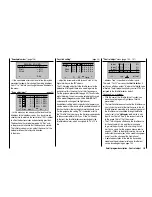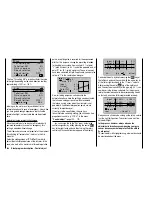
276
Detail program description - Control adjust
F3A model
F3A models are a part of the group of motor-driven
winged models. They are powered by a combustion or
electric motor. Models with electric motors can be used
in both the electric acrobatic class F5A and are also
competitive in the international model acrobatic class
F3A.
The basic comments and notices for the mechanical
installation of a remote steering system, which was
already referred to in the fi rst programming example on
page 236, also applies, of course, for F3A models and
does not need to be mentioned here again.
Faultlessly constructed F3A models exhibit a largely
neutral fl ying behavior. Ideally, they react with a good
nature but precisely to control movements without the
individual fl ight axes infl uencing one another.
F3A models are controlled with ailerons, elevator
and rudders. Normally, each aileron is actuated by a
separate servo. There is also the regulation of the drive
output of the motor (throttle function) and a retractable
landing gear in many cases. The assignment of the
channels 1 to 5, therefore, do not differ from the
previously described winged models.
The additional "Retractable landing gear" function is
to be provided on one of the auxiliary channels 6 to
9. It is best to actuate the landing gear with a switch
without center position. In addition, another mix offset
for the carburetor can – if necessary – be provided. You
normally use one of the two proportional rotary controls
on the transmitter, which actuates one of the unassigned
auxiliary channels.
Receiver power supply
Free or aux. function
Free or aux. function
Rudder
Aileron or left aileron
Elevator or 1st elevator
Free or 2nd elevator or aux. function
Receiver power supply
Airbrake or throttle servo
or speed controller (electric motor)
Right aileron
Free or aux. function (retracts)
Free or aux. function (mixture)
Free or aux. function
Free or aux. function
With the assignment of auxiliary channels at the
transmitter, we recommend making sure that the
operating elements required for this are easily
within reach, because during fl ight – especially in
competition – you have "very little time" to release the
joystick.
Programming
Since the basic programming of the transmitter was
already described in detail on pages 236 … 243, only
F3A-specifi c tips are added here.
In the menu …
"Servo adjustment"
(page 90)
S1
S2
S3
Rev
cent
+
tr v
0%
0%
0%
100% 100%
100% 100%
100% 100%
0%
0%
100% 100%
100% 100%
S4
S5
… the settings for the servos are carried out. Experience
has shown that working with at least 100 % servo
throw is benefi cial, because the control precision
is signifi cantly better if greater servo travel is used.
This should already be taken into account during the
construction of the model in the design of the rudder
linkages. Check the servo's direction of rotation. The
servo center should be adjusted mechanically, insofar as
possible.
Any corrections can be made on the software side in the
third column during the initial test fl ights.
Through the menu …
"Model type"
(page 82 )
… the idle trim is activated for Channel 1 (normally
"rear", because full throttle is "front"). The trimming then
only works in the idle direction:
Tail type
Motor at C1
Nor mal
Aile/flaps
2AIL
M O D E L T Y P E
Brake Off
In 1
+100%
SEL
back
The remaining settings are made or left as shown in the
fi gure.
Summary of Contents for mx-20 Hott
Page 41: ...41 Your notes...
Page 49: ...49 Your notes...
Page 55: ...55 Your notes...
Page 81: ...81 Your notes...
Page 85: ...85 Your notes...
Page 89: ...89 Your notes...
Page 99: ...99 Detail program description Control adjust...
Page 127: ...127 Detail program description Control adjust...
Page 131: ...131 Detail program description Control adjust...
Page 163: ...163 Detail program description Control adjust...
Page 191: ...191 Detail program description Control adjust...
Page 207: ...207 Detail program description Control adjust...
Page 228: ...228 Detail program description Control adjust...
Page 229: ...229 Detail program description Control adjust...
Page 251: ...251 Detail program description Control adjust...
















































